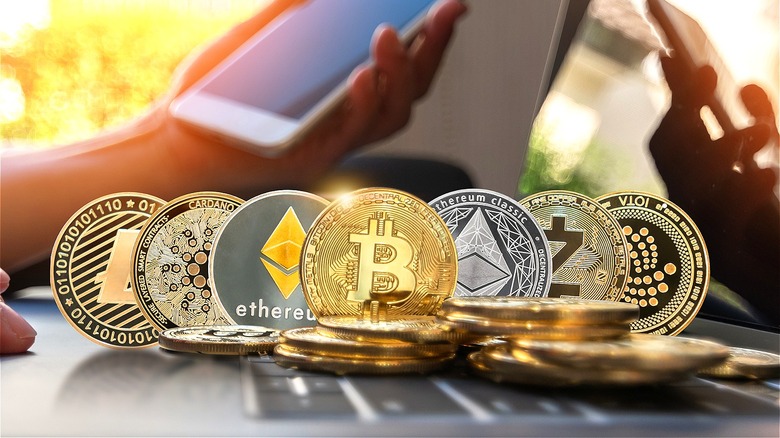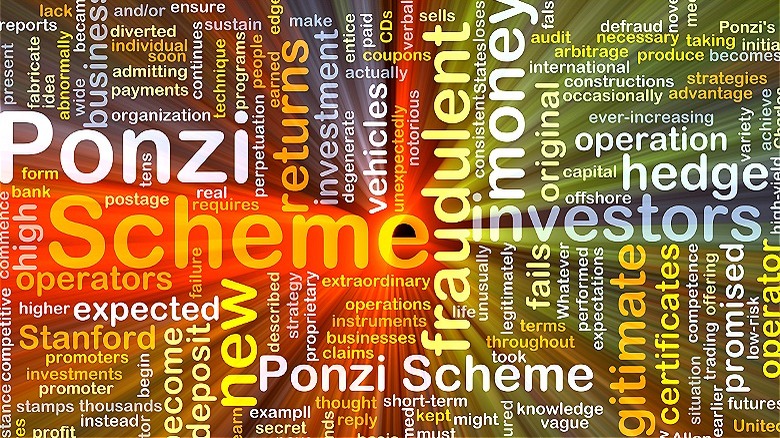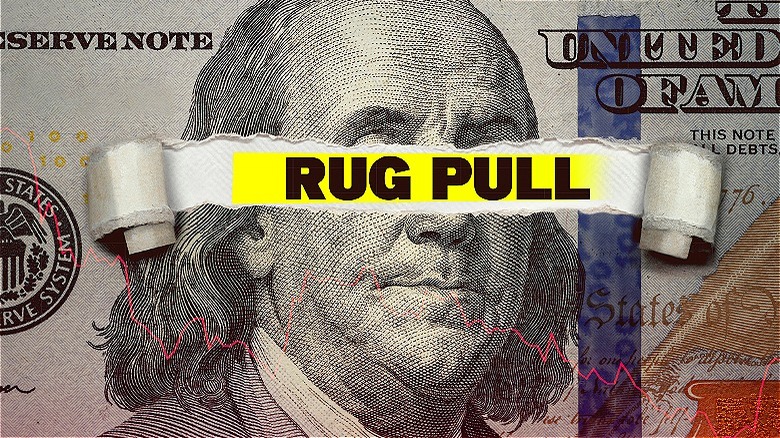The Biggest Crypto Scams To Look Out For In 2024
Bitcoin hit an all-time high of over $65,000 in November 2021. Approximately one year later, the value of the flagship cryptocurrency had retracted all the way back to the $ 16,000 range. In spite of that precipitous drop, bitcoin has since recovered to a value of more than $40,000 and many Bitcoin true believers are confident that the OG digital currency is on its way to a six-figures — more than $100,000, that is.
Bitcoin's meteoric recovery has drawn interest in other lesser-known cryptocurrencies, known as altcoins, which typically have a lower price of entry for investors compared to bitcoin. However, the potential to profit from buying altcoins also comes with risk of the getting scammed. The increasing popularity, as well as public awareness, of crypto has attracted a commensurate number of dishonest swindlers. Coupled with a reduced amount of regulation compared with other investments, crypto can be a dream environment for scammers.
Case in point: According to the Federal Trade Commission, in the 15 months between January 2021 and March 2022, more than 46,000 people lost a combined $1 billion-plus to cryptocurrency scams — more than any other payment method. But while concerning, don't fret, as Money Digest takes a look at five common fraudulent scenarios to beware of if you decide to wade into the brave new world of crypto in 2024.
1. Pump-and-dump schemes
Although the concept of the pump and dump — traditionally applied to shares of stocks — has been explored in films such as "The Wolf of Wall Street," it's worth explaining again to newbie investors. The premise is fairly simple. Perpetrators create or accumulate a large quantity of an altcoin (or other asset), then heavily promote the instrument. In particular, inorganic hype is created on social media or message boards to increase awareness and fraudulently inflate the price. That portion of the scam is the "pump."
Once a significant buzz, and therefore demand, has been created, the crypto scammers will unload their coin holdings at the artificially elevated price. That heavy selling floods the market and the asset price quickly falls as a result. This is the "dump" part of the equation. Amidst a fresh lack of demand and resultant oversupply, the value of the promoted altcoin then plummets.
To avoid getting ensnared in a pump-and-dump scenario with cryptocurrency, be vigilant against investing in assets that allocate coins to a very small, or even a single, number of entities, which places too much control over the asset in the hands of a few. Similarly, inspect the reputation and history of the founders, including whether they've been involved in past suspicious behavior. Finally, if you encounter a situation where a social media or other type of post about the coin project doesn't allow comments or has an inflated number of likes per number of views, those tells can indicate deceptive behavior.
2. NFT scams
Besides cryptocurrency coins, an adjunct vehicle for crypto investors has emerged in the form of cryptographic tokens called NFTs, which is short for non-fungible tokens. NFTs build on the concept of peer-to-peer transactions without any oversight, a cornerstone of early cryptocurrencies. Simply put, an NFT is a unique digital piece of art. The definition of "non-fungible" means that the token is unique and can't be replaced with anything else, unlike coins that can be replaced with identical other coins. So that covers the unique aspect, but the art itself can be virtually anything, ranging from drawings to music to bespoke videos.
Certain NFTs have sold for hundreds of thousands and even millions of dollars. Needless to say, whenever that kind of money is being splashed around, the potential exists for fraud. Although NFT values have slumped from their peak, wading into this unique and whimsical space still warrants caution. To begin, fraudsters have been known to convert or copy an artist's work into an NFT without the artist's permission, essentially rendering it a fake.
Another cautionary tale involves selling an NFT that you either own or created for a certain price, only to have the buyer change the method of payment at the last minute — typically, to a much less valuable coin. For example, if an NFT sold for four units of ether worth approximately $10,000, a scammer might try to switch the payment method to four units of Dogecoin worth about $0.32, so double-check that the crypto used for payment is the same as originally agreed upon.
3. Ponzi schemes
To some conservative investors who haven't yet hopped on the crypto bandwagon, all coins might seem like one giant Ponzi scheme at first glance. In fact, legendary investor Warren Buffett has been one of cryptocurrency's most outspoken critics. At a 2022 Berkshire Hathaway shareholder meeting, the "Oracle of Omaha" said of bitcoin, "it doesn't produce anything" (via CNBC). Buffett elaborated, "If you told me you own all of the bitcoin in the world and you offered it to me for $25, I wouldn't take it because what would I do with it?" He continued, "I'd have to sell it back to you one way or another. It isn't going to do anything."
That sentiment is indeed concurrent with the premise of a Ponzi scheme, which the U.S. Securities and Exchange Commission defines as "an investment scam that involves the payment of purported returns to existing investors from funds contributed by new investors." Of course, if your definition is broad enough, that same caution could be applied to any rapidly appreciating financial instrument. However, crypto is an easier target for fraudsters because of its relative newness and unfamiliarity, even among veteran investors.
In particular, with this kind of crypto scam, steer clear of unregistered offerings, unfamiliar trading platforms, or a promised rate of return that seems too good to be true. A prime example of the latter exists in BitConnect, which had promised incredible returns of up to 40% per month to investors who exchanged their bitcoin for the Bitconnect tokens, which later became worthless when the platform abruptly shut down.
4. Phishing scams
Phishing campaigns were a perennial favorite money scam of fraudsters long before anyone ever heard the term cryptocurrency. The crux of a phishing scam involves scammers attempting to steal or gain unauthorized access to a user's funds or payment methods, like credit cards, by sending mass emails with a fraudulent link to a realistic-looking website, which then captures passwords or other information.
Especially with the advent of images created with AI, it's easy for dishonest types to mimic the legitimate websites of financial institutions, retailers, or crypto exchanges. Often, the fake website is so similar to a company's actual website that unsuspecting victims will enter their login credentials as requested, only to later realize this private information was compromised. In the case of a crypto scam, the most common phishing target is the key to the cryptocurrency holder's wallet. Since digital wallets typically have just one unique key, it can be extremely troublesome or even impossible to resolve if the key is compromised by a scammer. Opening an entirely new wallet may be the only option.
To avoid crypto phishing scams, pay attention to the exact wording of the email or linked website. Oftentimes, phishing emails have mistakes in spelling and/or grammar, either because of the rushed preparation of the website or because the scammers aren't fluent in English. Also, review the sender's email address, which may clearly be from a personal email account and not a legitimate company email address.
5. Rug pulls
The term "rug pull" derives from the expression "pulling the rug out from underneath." When it comes to crypto scams, it works like this: Typically, a new token will emerge that's both attractive and appears legitimate. As such, investors will lavish money on the new project with the hope it'll rise in value, only to have the principals of the project disappear, taking all the cash with them.
Per blockchain analysis company Chainalysis, rug pulls are prevalent in DeFi, i.e., decentralized finance. The reason? According to Chainalysis, "... because with the right technical know-how, it's cheap and easy to create new tokens on the Ethereum blockchain or others and get them listed on decentralized exchanges (DEXes) without a code audit." For the uninitiated, code audit means a third-party security check.
So what's the best way to stay safe from an evildoer absconding with your hard-earned cash? To begin, try to frequent reputable sites like Coinbase or Binance that review assets and have certain standards in place. Similarly, stick with well-known, established cryptocurrencies even though they may be pricier. Presently, the two largest are bitcoin and ether. As of early 2023, the third largest crypto coin had less than half the market cap of ether. Finally, rug pull scams will frequently borrow aesthetics and features from other popular projects. That lack of originality may be a sign that the project isn't a long-term priority for the creators and not worth your investment.





